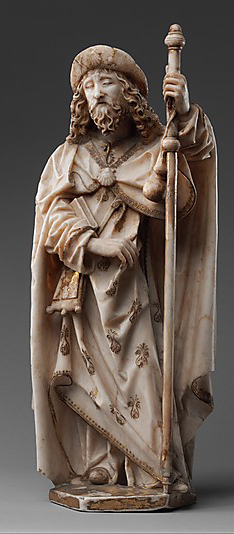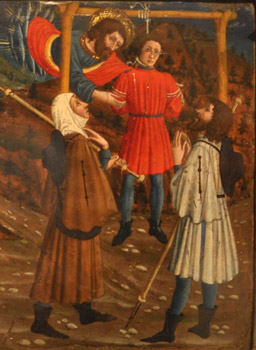THE CALLING OF JAMES AND JOHN, THE SONS OF ZEBEDEE
According to the synoptic gospels, when Jesus called the fisherman brothers James and John to his service they immediately left their father and his boat and became his disciples (image).1HIS PASSION AND DEATH
In the Golden Legend James's trial and beheading are precipitated by his converting a magician named Hermogenes. The beheading story is common enough in the art (example), but the Hermogenes episode (example) is more rare.HIS VISION OF THE VIRGIN OF THE PILLAR
A basilica dedicated to the Virgin in Zaragoza has a statue of her on a marble pillar. (See my page on the Virgen del Pilar.) Local tradition has it that James was on mission in that city in 40 A.D. when angels brought the Virgin Mary to ask him to build a chapel in her memory. The angels also brought James the pillar and the statue (image), and he immediately constructed the small shrine that over the years has been expanded into a magnificent cathedral.2PORTRAITS
In Groups of the ApostlesPortrait groups of the twelve apostles have been featured in churches and other venues since at least the 4th century. The earliest group with an identifiable portrait of James the Greater may be the mosaic in the Church of St. Pudentiana in Rome. Another early portrait is in the Apostles Group in the 6th-century apse mosaic at Poreč, Croatia. In the Pudentiana mosaic and other apostle groups, James the Greater often has a long white beard (example), although he looks more youthful when portrayed as a pilgrim (see below).
Arrayed as a Pilgrim
After the beheading, the Legend says that James's followers decided to put his body into a rudderless boat and sail with it to wherever God might choose. Eventually they landed in Galicia, where a large rock re-formed itself into a sarcophagus for the body.
The rest of the story is picked up in the 12th-century Historia Compostellana, which says the location of the body was forgotten during the years of pagan and then Saracen ascendancy, and a woods grew up around the little house where the sarcophagus had been placed. Then in the 9th century some local people saw angels and brilliant illuminations appearing in the night in that same woods. They told the bishop, who went to the woods, found the house and the sarcophagus, and took the news to the king. As more and more pilgrims started visiting the place, the bishop built a basilica there.3
The place where the lights and angels were seen came to be called Compostela ("field of the star") and has been a pilgrimage destination since the ninth century. For this reason, St. James came to be represented in portraits as a pilgrim himself, always carrying a pilgrim's staff. He is usually dressed as in the first image on the right, in a broad-brimmed pilgrim's hat and an archaizing tunic and pallium. The staff often has a metal hook for hanging a water gourd (example). Usually James is barefoot, and he often holds a book, as in the first picture at right. The hat or some other part of the image is often decorated with a cockle shell (the conventional badge of a pilgrim who has been to Compostela), sometimes supplemented by a crossed pair of pilgrim staffs.
On a Horse as "Matamoros"
A 12th-century document from Compostela claims that St. James appeared to the troops on the eve of a fictional "Battle of Clavijo" against the Moors in 844, promising to be with them riding a white horse and bearing a white banner. As they went into battle they raised for the first time the war cry, "May God and St. James help us!" Fictional or not, the story inspired a new iconographic type in which the saint rides a white horse into battle. The earliest example of this type is a 12th-century tympanum carving at the cathedral in Compostela.4
This iconographic type is known as Santiago Matamoros, "Saint James the Killer of Moors." In it the saint is on horseback brandishing a sword, sometimes with defeated enemies at the horse's feet (example). The horse is not always white, and there is not always a banner.
In Latin America, the Matamoros type was adapted to justify the Spanish conquest, replacing the Moors with the putatively oppressive rulers of the indigenous peoples (example). Later, in a remarkable twist, 19th-century revolutionaries in Peru used images of the same saint in the same pose defeating their latter-day oppressors, the Spaniards (example).
The first three images below are examples of the three subtypes, with James conquering Moors, Indians, and Spaniards respectively.
In Orthodox Iconography
Orthodox images of St. James do not refer to the Campostela pilgrimage, relying on inscriptions to identify him. They usually picture the saint with a scroll (example), but some instances may give him a book, as is preferred in the West (example).
Prepared in 2014 by Richard Stracke, Emeritus Professor of English, Augusta University.
HOME PAGE

St. James as a pilgrim. A cockle shell adorns his hat and mantle, and he holds a staff in his right hand. His left arm cradles a book. (See the description page.)

A miracle of St. James: He saves the life of a hanged man. (See the description page for an explanation of the legends behind this painting.)
ATTRIBUTES
- Scallop Shell
- Pilgrim's staff and garb
MORE IMAGES
- 12th-century: manuscript illustration of St. James with his white horse and white standard
- 13th-century: stained-glass portrait of James as pilgrim
- 14th century: St. James tips over a prison tower in order to free a man unjustly imprisoned in this fresco in Padua's Basilica of St. Anthony.
- Early 14th century: St. James's portrait is among Aretino's panels of Apostles and saints in Santa Maria Novella, Florence.
- Mid-14th century: Paolo Veneziano's portrait of a youngish James.
- Circa 1368-88: Antonio Veneziano's St. James the Greater.
- 1390s: James the Greater stands with his pilgrim's staff among the other saints on the left wing of Cenni di Francesco's Coronation of the Virgin altarpiece.
- 1449: The saint's portrait in A. Vivarini's Polyptych of the Virgin and Child.
- 1466-67: The Pollaiolos' St. Vincent, St. James the Greater, and St. Eustace gives St. James a sumptuous pilgrim's hat and garb along with a quite credible pilgrim's staff.
- 1475-80: The saint is pictured in the center of a composite stained glass window from England.
- 16th century: James is one of the saints in Veronese's The Dead Christ and Saints.
- 1514: In Carpaccio's portrait of St. Vitalis
- 1546: St. James and St. Andrew flank Mary's throne in Lotto's Madonna and Saints.
- 1547-51: Santiago Matamoros in a Spanish altarpiece.
- 17th century: Zurbarán, Martyrdom of St. James the Greater
- 18th century: Giuseppe Angeli's portrait takes a naturalistic approach but retains the traditional attributes.
- 1753-55: Life-size statue in St. Peter's, Munich.
- 18th century: Life-size statue in the Lateran Basilica
- 19th century: St. James Intercedes for Caltagirone, a meditation on the nature and power of prayer.
- 1890: A portrait of St. James in traditional iconography in an English church.
- Not dated: High relief in Barcelona of Santiago Matamoros
- Not dated: Mexican folk sculpture of Santiago Matamoros
- Not dated: Paired with John the Baptist in a statue in wood and polychrome.
- Also see the section on St. James in our catalog of santos in Oaxaca, Mexico.
DATES
- Feast day: July 25
NAMES
- The Latin name is Jacobus. In Italy this became Giacobo, then Giacomo, from which English gets James and French gets Jacques.
- In eastern Spain, Giacomo became Jaime. In western Iberia it became Iago, which when prefixed with Sant in Portugal and Galicia became Santiago and its alternative San Diego.
BIOGRAPHY
- Golden Legend #99: html or pdf
- Acta Sanctorum, July vol. 6, 5-124
- South English Legendary, 33-45.
- pseudo-Abdias, 327-336
NOTES
1 Matthew 4:21-22, Mark 1:19-20, Luke 5:10.
2 Written instances of the legend go back only to a 13th-century manuscript reprinted in Acta Sanctorum, July vol. 6, 115f. There is also a reference to the basilica and its ancient status in a papal document from 1118 (ibid., p. 116).
3 The relevant passage in the Historia Compostellana is in Acta Sanctorum, July vol. 6, 16. The entire Historia is available in Emma Falque Rey's edition and translation.
4 O'Callaghan, 194-95. The document is the so-called Privilege of the Vows of Santiago, printed in L�pez Ferreiro, II, 132-37.